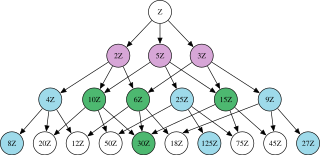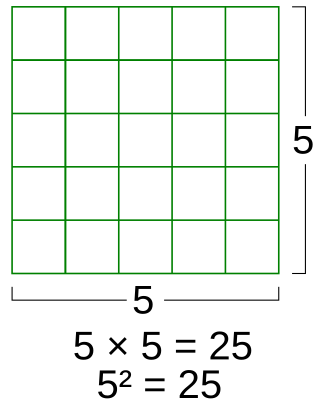Related Research Articles
In mathematics, particularly abstract algebra, an algebraic closure of a field K is an algebraic extension of K that is algebraically closed. It is one of many closures in mathematics.

In algebra, a prime ideal is a subset of a ring that shares many important properties of a prime number in the ring of integers. The prime ideals for the integers are the sets that contain all the multiples of a given prime number, together with the zero ideal.
In ring theory, a branch of mathematics, an idempotent element or simply idempotent of a ring is an element a such that a2 = a. That is, the element is idempotent under the ring's multiplication. Inductively then, one can also conclude that a = a2 = a3 = a4 = ... = an for any positive integer n. For example, an idempotent element of a matrix ring is precisely an idempotent matrix.
In ring theory, a branch of mathematics, a radical of a ring is an ideal of "not-good" elements of the ring.

In mathematics, a square is the result of multiplying a number by itself. The verb "to square" is used to denote this operation. Squaring is the same as raising to the power 2, and is denoted by a superscript 2; for instance, the square of 3 may be written as 32, which is the number 9. In some cases when superscripts are not available, as for instance in programming languages or plain text files, the notations x^2 (caret) or x**2 may be used in place of x2. The adjective which corresponds to squaring is quadratic.
In mathematics, a von Neumann regular ring is a ring R such that for every element a in R there exists an x in R with a = axa. One may think of x as a "weak inverse" of the element a; in general x is not uniquely determined by a. Von Neumann regular rings are also called absolutely flat rings, because these rings are characterized by the fact that every left R-module is flat.
In abstract algebra, a Jordan algebra is a nonassociative algebra over a field whose multiplication satisfies the following axioms:
- .
In ring theory and homological algebra, the global dimension of a ring A denoted gl dim A, is a non-negative integer or infinity which is a homological invariant of the ring. It is defined to be the supremum of the set of projective dimensions of all A-modules. Global dimension is an important technical notion in the dimension theory of Noetherian rings. By a theorem of Jean-Pierre Serre, global dimension can be used to characterize within the class of commutative Noetherian local rings those rings which are regular. Their global dimension coincides with the Krull dimension, whose definition is module-theoretic.

Irving Kaplansky was a mathematician, college professor, author, and amateur musician.
In abstract algebra, Morita equivalence is a relationship defined between rings that preserves many ring-theoretic properties. More precisely two rings like R, S are Morita equivalent if their categories of modules are additively equivalent. It is named after Japanese mathematician Kiiti Morita who defined equivalence and a similar notion of duality in 1958.
The mathematician Irving Kaplansky is notable for proposing numerous conjectures in several branches of mathematics, including a list of ten conjectures on Hopf algebras. They are usually known as Kaplansky's conjectures.
In algebra, a Hilbert ring or a Jacobson ring is a ring such that every prime ideal is an intersection of primitive ideals. For commutative rings primitive ideals are the same as maximal ideals so in this case a Jacobson ring is one in which every prime ideal is an intersection of maximal ideals.
In abstract algebra and functional analysis, Baer rings, Baer *-rings, Rickart rings, Rickart *-rings, and AW*-algebras are various attempts to give an algebraic analogue of von Neumann algebras, using axioms about annihilators of various sets.
In the area of abstract algebra known as ring theory, a left perfect ring is a type of ring over which all left modules have projective covers. The right case is defined by analogy, and the condition is not left-right symmetric; that is, there exist rings which are perfect on one side but not the other. Perfect rings were introduced in Bass's book.
In mathematics, specifically ring theory, the notion of quasiregularity provides a computationally convenient way to work with the Jacobson radical of a ring. In this article, we primarily concern ourselves with the notion of quasiregularity for unital rings. However, one section is devoted to the theory of quasiregularity in non-unital rings, which constitutes an important aspect of noncommutative ring theory.
In mathematics, more specifically abstract algebra, a finite ring is a ring that has a finite number of elements. Every finite field is an example of a finite ring, and the additive part of every finite ring is an example of an abelian finite group, but the concept of finite rings in their own right has a more recent history.
In mathematics, a Goldman domain or G-domain is an integral domain A whose field of fractions is a finitely generated algebra over A. They are named after Oscar Goldman.
In mathematics, especially ring theory, a regular ideal can refer to multiple concepts.
In mathematics, a Zorn ring is an alternative ring in which for every non-nilpotent x there exists an element y such that xy is a non-zero idempotent. Kaplansky (1951) named them after Max August Zorn, who studied a similar condition in.
In mathematics, an AW*-algebra is an algebraic generalization of a W*-algebra. They were introduced by Irving Kaplansky in 1951. As operator algebras, von Neumann algebras, among all C*-algebras, are typically handled using one of two means: they are the dual space of some Banach space, and they are determined to a large extent by their projections. The idea behind AW*-algebras is to forgo the former, topological, condition, and use only the latter, algebraic, condition.
References
- Jacobson, Nathan (1956), Structure of rings, American Mathematical Society, Colloquium Publications, vol. 37, Providence, R.I.: American Mathematical Society, ISBN 978-0-8218-1037-8, MR 0081264, Zbl 0073.02002
- Kaplansky, Irving (1972), Fields and Rings, Chicago Lectures in Mathematics (2nd ed.), University Of Chicago Press, pp. 124–125, ISBN 0-226-42451-0, Zbl 1001.16500